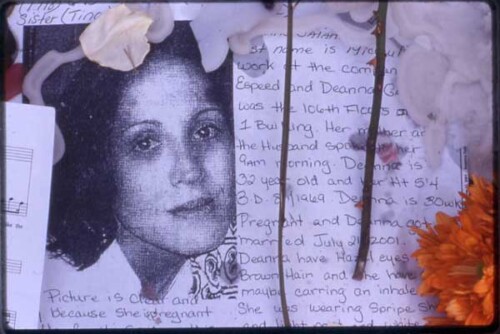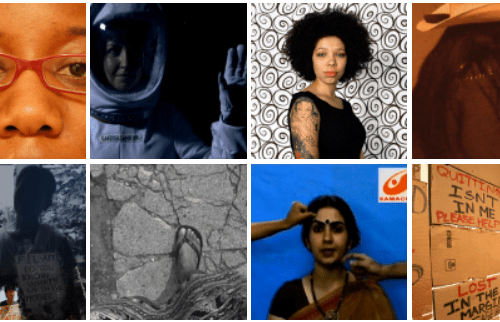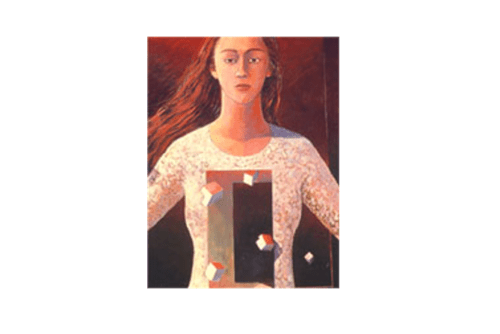What do We See in Performances Today?
Most of the feminist theatre companies, like the feminist book store collectives, had disappeared in the United States by the mid 1990s. Not only is it always difficult for small theatre companies to survive on what amounts to no fiscal support from the government, it has become even more difficult to survive in recent years in a conservative climate and with fewer and fewer dollars available for arts funding. Similarly in Britain, the Thatcher years took a heavy toll on left-wing and feminist theatre companies, perhaps the most well known casualty of that era being Monstrous Regiment, who for over twenty years had managed to thrive and produce many pieces created by and for women with explicit socialist feminist politics as their artistic mission. In 2001-2002, on off-Broadway and in regional theatre’s two thousand productions, 16% were written by women and 17% had female directors. Solo performers have managed to survive the best – one thinks of Bobbie Baker in Britain or Karen Finley or Holly Hughes in the U.S., and most prominently, of Anna Deavere Smith whose solo work has been widely seen in the mainstream through television broadcasts of her work and Broadway and major U.S. regional productions. In Britain, some women playwrights have remained well established through the 90s – Caryl Churchill and Timberlake Wertenbaker, for example, are feminist writers from the Second Wave who still write and are produced in major venues such as the National Theatre and the Royal Court. As for directors, Ann Bogart or JoAnn Akalatis in the U.S. and Deborah Warner and Di Trevis in the U.K. have achieved a great deal of critical acclaim and work in the major professional theatres in both countries. “Feminist”, however, would not be a descriptive term brought easily to their work, although two of them would self-describe as feminists in their “private” life. Only Warner consistently thematizes gender issues in her directorial work, and that is complicated by her well-known lesbian partnership with Fiona Shaw, with whom she has created many projects such as the cross-dressed Richard II. Dance companies such as DV8 in Britain or Bill T. Jones’s company in the U.S. thematize gender and sexuality, but both are more identified with queer performances than with anything that might be called feminist, and both are heavily concerned with masculinity and its representations.
One of the early concerns of feminist representation was to get women in central roles represented as legitimate protagonists of dramas – not just in order to create more roles for women, but to treat their lives, in a gloss on the words of Erich Auerbach in Mimesis, as serious subjects, to ensure “the rise of more extensive and socially inferior human groups to the position of subject matter for problematic-existential representation.”1 Along with this objective came the reclaiming of women’s history. To some extent, these features continue to be present in the contemporary work of most of the women artists mentioned above, but they may not be as central or as sufficient as they once were. Di Trevis’s stunning production of Proust’s Remembrance of Time Past (2001), for example, foregrounds a gay male imagination perhaps, but no particular stress on female representation or feminist features can be claimed for it. Ann Bogart’s recent tour de force, Bob, is a solo piece about Robert Wilson. It goes a long way to explaining a great deal about this theatrical artist and his work, but obviously has nothing to do with women, nor are there any on the stage.
I want to speak briefly about three playwrights for whom some claims, the claims of the residue of feminism if not more, can be made. The most straightforward is Caryl Churchill whose recent work from The Skryker to 2001’s Far Away still involves women at the center of the action, and still concerns itself with the quality of women’s lives in contemporary society. Far Away, however, is questionably about women’s issues. Set in a world of some undisclosed future, it appears to be about species alienation and warfare, where all God’s creatures are divided into warring camps. One of the characters explains who the bad guys are: “Mallards are not a good waterbird. They commit rape, and they’re on the side of the elephants, and the Koreans. But crocodiles are always in the wrong” (33). In this Brave New World, conflict is ever-present and loyalties keep changing. The one overtly feminist through-line is that the little girl of the first scene, Joan, raises questions about immigrants who appear to be being beaten by her uncle. In the course of the play, she grows up into the world of this global species warfare. Consistently through all of Churchill’s work, and often figured specifically as a child character, there is a concern for the experiences and future of young girls. What kind of world will they inhabit and inherit, might be her constant question. Is this enough to count as a feminist text? Or is the concern with globalization, usually taken to be at the heart of her play, beyond feminism?
The second play is Sarah Kane’s last play, 4.48 Psychosis. Kane has come to prominence in the U.K. but also in Europe, especially in Germany where her plays have received many productions. She is generally recognized as a great talent, with power in her writing that compares to Edward Bond and even Samuel Beckett. She was born in 1971, just at the start of second wave feminism, and she died of suicide in 1999. Young, gifted, and dead. Certainly not a feminist, but a woman writer. What are we to say of her? Her plays have been received as shocking because of her depictions of brutality and violence and the seeming lack of redemption in her imaginary universe. Critics puzzle about the nihilism of her plays (whether they really are), and about the style and her expression – poetic, anti-realistic, dramaturgically unique. They haven’t written about her in terms of feminism. Her last play, 4.48 Psychosis is itself about depression and suicide, and it is almost impossible to resist seeing it as her last words. Here is an excerpt: “I can’t think/I cannot overcome my loneliness, my fear, my disgust/I am fat/I cannot write/I cannot love/My brother is dying, my lover is dying, I am killing them both/I am charging toward my death/I am terrified of medication/I cannot make love/I cannot fuck/ I cannot be alone/ I cannot be with others/ My hips are too big/ I dislike my genitals/ At 4.48 when desperation visits I shall hang myself to the sound of my lover’s breathing/I do not want to die/I have become so depressed by the fact of my mortality that I have decided to commit suicide/I do not want to live” (207). This excerpt is full of the very sort of self-loathing expressions second wave feminism tried to fight – preoccupation with the imperfect body, lack of self image or sense of self value, depression, guilt, masochism. The typical narrative for women in drama, we were told, is transgression followed by death – thus Hedda Gabler, Marie in Woyzeck, all the opera heroines, of course Carmen. We must stop representing death as inevitable for women who dare to be different, we feminist critics thought. And here is Sarah Kane, who makes a definitive performance of her life, by creating her art and doubling it in her tragic actions. She willed it, she chose it, yet she didn’t, yet she provides an example of the seeming lack of escape from the deep desolation of the feminine psyche. How can I call her feminist? The via negativa of her example is a protest. Kane was angry at the world as well as at herself. She demanded her audiences pay attention to real suffering, her own but also others. Blasted is often described as Kane’s response to Bosnia – not literally, not citationally, but to the situation of violence and disengagement of the West. Like Churchill in Far Away, the global demanded the foreground of her response. Might we not see the residue of feminism, its ethical and political commitments, even in her seeming rejection of it?
The third play is by Suzan-Lori Parks an African American playwright who in 2002 received the Pulitzer Prize for her play, Top Dog/Under Dog. Sometimes her work has been very close to second wave feminist work – I am thinking specifically of Venus, her 1996 play about the historical figure Saartjie Baartman, the “Venus Hottentot,” who was exhibited in side-shows in London in the 19th century because of her large buttocks. Here, Parks raises questions of representation (both how she was represented historically and how to represent her today – Saartjie sometimes appears in a padded suit to avoid realistic portrayals that would invite voyeurism by providing an unmediated object for a male racialized gaze.) Parks offers a kind of socialist feminist analysis of the economic and racial causes of Baartman’s exploitation, combining race and gender in a devastating critique of white capitalist and masculinist culture while inserting Baartman firmly into history. Yet this play is not typical of her work, which has ranged over many topics and expressions, including The America Play and The Death of the Last Black Man in the Whole Entire World, both of which feature only supporting female characters and treat men as explicitly central. Top Dog/Under Dog has no female characters at all, although African-American performance scholar Harry Elam has remarked that the play ironically contains a female voice in its absence and silence. Parks commented in an interview, “Just being an African-American woman on Broadway is experimental. As far as I know, there are only four of us: Lorraine Hansberry, Ntzoke Shange, Anna Deavere Smith, and me. It’s also experimental to write a play that just involves two men and to write it so well that people think a man wrote it!”
What I am suggesting, of course, is that while these plays seems to lack the overt marks of explicitly feminist commitment, they are informed by and filtered through the perspectives of women who have been familiar with and lived in relation to second wave feminism. Even Sarah Kane, youngster of the group, knew the themes and preoccupations of Second Wave Feminism. She sometimes satirized them, as in Phaedra’s Love, and sometimes charted their inadequacy to capture real lives of suffering, as in Blasted or Cleansed. Suzan-Lori Parks doesn’t consider herself feminist, and has what she must define as larger questions of race and nation at the center of her work, but when she writes a play like Venus, she reveals how well she knows the socialist feminist critique and adapts it for her own purposes. Churchill continues to identify as feminist, but her work is becoming more diffuse, less epic and more lyrical, and more removed from the familiar feminist writing of Cloud 9 or Top Girls. So while none of this work is overtly feminist, it is imbued with second wave residue, the presence of the “post,” the effects of coming after and of having encountered Second Wave feminism. And, I would submit, this is not a negligible legacy.
- Erich Auerbach, Mimesis: The Representation of Reality in Western Literature, Trans. By Willard R. Trask, Princeton University Press, 1953, 491. [↩]




